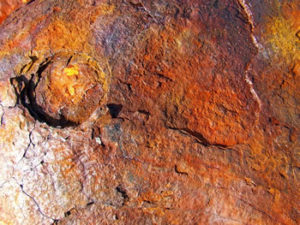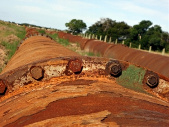What is Rust and where is it Common
 Rusting is the process in which iron or steel corrodes, everyone should understand how rust forms and where to look for it in your home/business.
Rusting is the process in which iron or steel corrodes, everyone should understand how rust forms and where to look for it in your home/business.
Rusting takes place when iron is in continuous contact with oxygen, the process is called oxidation. The oxygen that causes rust is delivered in water, either in its liquid state or gaseous (water vapor/fog). The carbon dioxide in the air in combination with the water creates a carbonic acid, this breaks down the water to its molecular state (hydrogen and oxygen), and this also causes some of the iron in the metal to dissolve. The oxygen molecules bond to the dissolved iron creating iron oxide (rust). There are certain catalyst to the rusting process (speeding it up), these include: salt water, acid and acid rains, soil, and gaseous sulfur compounds. Any architectural cracks and crevices will hold water and will accelerate the rusting process.
It is also beneficial to understand what kind of metals is susceptible to rust, and how to identify them. Any iron, or iron alloy like steal (including stainless and galvanized) will be susceptible to rust. Now this is not to say that other metals won’t corrode, but they will not rust. Iron is typically dark in color and it is magnetic, all of its alloys have the same magnetic property so if you are unsure, for the most part if it is magnetic and in your home it can rust.
The first area that rust is commonly found in a home is the foundation. Now you may thing that the foundation is just concrete, that is not the case though, and when a foundation is poured the use of steel rebar to reinforce the concrete is common. Now in most cases the concrete effectively entombs the rebar, however if the concrete is not sealed correctly moisture will penetrate into it, and in doing so it will begin the rusting process of the rebar sub-structure. This can be very difficult to spot because you cannot see the rebar, what you can see is the surface of the concrete, it is important to inspect the concrete for weak spots. Any cracks or chips in the concrete will be an easy point of entry for moisture to get to the rebar and begin the rusting process. This can be without a doubt the most costly; it is a time consuming and labor intensive process.
Another area in a home where rust is common is on the roof, especially roofs that are steel. This most commonly happens when a steel roof is coated with a sealer without first being cleaned and scraped, the result is moisture trapped under the sealer leading to rust issues. This is not the only type of roofing that can be susceptible to rust though. Another common occurrence is when the nails used to install shingles or similar product rust. This leads to single shingles or even whole sections peeling away. Other areas that should be inspected regularly are: fuel oil tanks, hot water heaters, fences/railings, and electrical panels.
